helmeted squash bug
(Euthochtha galeator)
Conservation • Description • Habitat • Ecology • Distribution • Taxonomy
|
|
||||||||||||||
Description |
Helmeted squash bug is a common, medium-sized, leaf-footed bug. It occurs in the United States east of the Great Plains and in southern Ontario Canada. Adults are found from late May to early July and from early mid-August through October. Their absence in mid-summer suggests that overwintered adults die off before the new generation reaches maturity. Both adults and nymphs feed on a variety of plants. Adults are dull brown or reddish-brown, elongated oval, ⅝″ (15 to 17 mm) long, and 3⁄16″ to ¼″ (5.0 to 6.5 mm) wide. The body is flattened above and convex below when viewed from the side. The head is short, squarish, and wider than long. The front of the head is divided into a central lobe (tylus) and two lateral lobes (juga). It does not extend forward between the antennae bases. There are two large, widely spaced, compound eyes on the sides of the head and two small simple eyes (ocelli) on the top of the head between them. There is a distinct raised bump (tubercle) behind each compound eye. The antennae are borne on prominent projections (tubercles) on the upper part of the cheeks (gena). The space between the tubercles is vacant. Each tubercle has a small blunt spine on the outer side. The antennae have four segments. Segments 1 through 3 are dull yellow or reddish-brown. Segment 1 is slightly swollen and twice as long as the head. Segment 4 is darker, bristly, and spindle-shaped, tapered at both ends. The mouth parts are optimized for piercing and sucking, and take the form of a thick, curved, 4-segmented beak (rostrum). The rostrum fits into a groove on the underside (sternum) when not in use. It is stout and short, longer than the head but just reaching the bases of the middle pair of legs. The thorax is twice as wide as long. The exoskeletal plate covering the thorax (pronotum) is coarsely and irregularly pitted. The lateral margins have 5 to 10 small, blunt teeth. The front corners (humeral angles) jut outward forming a large, rounded tooth. There is no spine at the tip. The upper surface is finely and unevenly pitted. On the male there is a conspicuous cream-colored flap on each side at the rear corner of the thorax. There are two pairs of wings, and they are held flat over the body when at rest. Between the wing bases there is a large plate (scutellum). The scutellum is broadly triangular, whitish at the very tip, and crossed by fine longitudinal wrinkles. The forewings (hemelytra) are as long as the abdomen but do not completely cover the sides of the abdomen. The sides of the abdomen are extended, flattened, and exposed (connexivum). The connexivum is conspicuously striped with brown and whitish or yellowish. On the female the connexivum on each side is slightly prolonged at the rear tip, appearing as a pair of teeth at the end of the abdomen. The hemelytra have a thickened, leathery section at the base and a thin membranous section at the tip with a clear dividing line between the two. The membrane is dark brown. Some of the veins in the membrane are forked, some fork and rejoin, network-like (anastomosing). The third segment (femur) of each leg has spines on the underside. On the male The femurs on the hind legs is moderately swollen, curved, and bumpy (tuberculate) on the upper side. On both sexes the fourth segment (tibia) of all legs is yellowish and straight. On the front and middle legs, they are spotted with dark brown. On the hind legs they are unspotted. The last part of each leg (tarsus), corresponding to the foot, has three segments. Nymphs are very spiny, and the third antennal segment is dilated. |
Size |
Total length: ⅝″ (15 to 17 mm) Width: 3⁄16″ to ¼″ (5.0 to 6.5 mm) |
Similar Species |
Habitat |
|
Ecology |
Season |
One generation per year: Late May to early October. |
Behavior |
When disturbed, adults will either fly away quickly or drop to the ground and remain motionless, feigning death. |
Life Cycle |
Adults overwinter. |
Nymph Food |
|
Adult Food |
|
Distribution |
||
|
Sources |
|
| 6/23/2024 | ||
Occurrence |
||
Common |
||
Taxonomy |
|
Order |
Hemiptera (True bugs, Hoppers, Aphids, and Allies) |
Suborder |
Heteroptera (True Bugs) |
Infraorder |
Pentatomomorpha |
Superfamily |
Coreoidea (leaf-footed bugs and allies) |
Family |
Coreoidea (leaf-footed bugs) |
Subfamily |
Coreinae |
Tribe |
Acanthocerini |
Genus |
Euthochtha |
Subordinate Taxa |
|
|
|
Synonyms |
|
Acanthocerus galeator Coreus galeator Coreus tibialis Crinocerus tibialis |
|
Common Names |
|
helmeted squash bug |
|
Glossary
Anastomosing
Referring to veins, such as on a plant leaf or a lichen, that branch and rejoin, forming a network.
Connexivum
In Heteroptera: the enlarged, flattened margins of the abdomen. Plural: connexiva.
Corium
The thickened basal portion of the front wing that lies between the clavus and the membrane of insects in the family Hemiptera. Plural: coria.
Femur
On insects and arachnids, the third, largest, most robust segment of the leg, coming immediately before the tibia. On humans, the thigh bone.
Gena
In insects: The area between the compound eye and the mandible; the cheek. In birds: The area between the the angle of the jaw and the bill; the feathered side (outside) of the under mandible. Plural: genae.
Scutellum
The exoskeletal plate covering the rearward (posterior) part of the middle segment of the thorax in some insects. In Coleoptera, Hemiptera, and Homoptera, the dorsal, often triangular plate behind the pronotum and between the bases of the front wings. In Diptera, the exoskeletal plate between the abdomen and the thorax.
Tarsus
On insects, the last two to five subdivisions of the leg, attached to the tibia; the foot. On spiders, the last segment of the leg. Plural: tarsi.
Tibia
The fourth segment of an insect leg, after the femur and before the tarsus (foot). The fifth segment of a spider leg or palp. Plural: tibiae.
Tubercle
On plants and animals: a small, rounded, raised projection on the surface. On insects and spiders: a low, small, usually rounded, knob-like projection. On slugs: raised areas of skin between grooves covering the body.
Visitor Photos |
||
Share your photo of this insect. |
||
This button not working for you? |
||
Mike Poeppe |
||
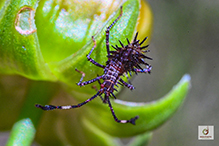 |
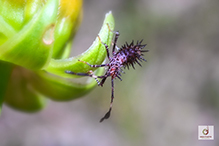 |
|
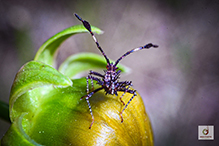 |
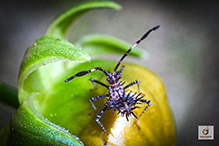 |
|
Babette Kis |
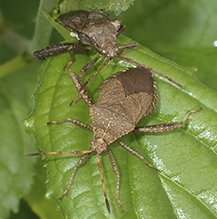 |
Euthochtha galeator (helmeted squash bug) Euthochtha galeator (helmeted squash bug) at Barnes Prairie Remnant, Racine Co., WI, photographed on June 28, 2021. On low-growing shrub. |
Alfredo Colon |
||
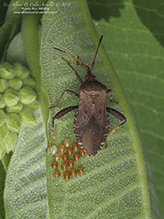 |
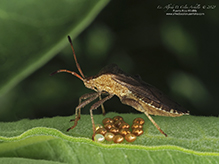 |
|
MinnesotaSeasons.com Photos |
||
|
||
|

Slideshows |
|

Visitor Videos |
||
Share your video of this insect. |
||
This button not working for you? |
||
|
Other Videos |
||
Helmeted Squash Bug Nymph (Coreidae: Euthochtha galeator) on Leaf |
About
Aug 7, 2011 I used the blunt end of my pen to coax this specimen into a better position for viewing. Photographed at Red Wing, Minnesota (04 August 2011). Thank you to Mike Quinn (@Bugguide.net) for confirming the identity of this specimen! |
HELMETED SQUASH BUG Euthochtha galeator |
About
Feb 11, 2017 Euthochtha galeator = HELMETED SQUASH BUG. Waterfall Glen FP, IL. 9/17/2016. |

Visitor Sightings |
||
Report a sighting of this insect. |
||
This button not working for you? |
||
Mike Poeppe |
Location: near Houston, MN |
 |
| Alfredo Colon 6/8/2021 |
Location: Woodbury, MN |
 |
MinnesotaSeasons.com Sightings |
||
|

Created: 12/17/2022 Last Updated: © MinnesotaSeasons.com. All rights reserved. |

